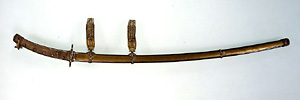Inariyma small Kaji. Swordsmith / Munechika let a messenger of Inari chime in and finished a celebrated sword called the little fox-maru.
The power of the samurai family increases in the days of peace from a position in pre-9 when samurai family power became particularly active and the position area of Gosannen in the latter period, and a sword develops with this and usually does things after this with a Japanese sword. Each school of the swordmaker appeared in Yamashiro state / the Yamato country which was cloud Haku border area and Bizen country and the center of the political culture where high quality iron sand was produced. The sword that the Japanese sword of these days was thought about mainly on an Umaue decisive battle is the subject. "Little fox circle" (destroyed by fire at the time of Munechika Sanjo product of the Yamashiro country, World War II) with the legend that let "running out of apprentice to a priest" (the Yasushi rope product of the Hoki country, a national treasure) and a fox said to that Yorimitsu Minamotono cut the drinker apprentice to a priest of the river and mountain very much beat against 合鎚 is a Japanese sword representing this time. The Yasushi rope of the cloud Haku border that is the author of "the running out of apprentice to a priest" does the times with (about 806) to an old book of secrets in the Datong year of the beginning in the ninth century, but it is history of sword that watch with the time in ten end of the century at the peace middle, and it is it with a common view without stopping in the days of to there as far as I watch an existence work. Other than Yasushi rope, three lines of small Munechika Kaji of Yamashiro (Kyoto), Old Bizen Tomonari are considered to be the oldest swordmaker with the existence having the maker's name inscribed product.
I list below the characteristics of the sword of the Heian era. As for the finish, as for the width of the body (みはば), a spearhead (きっさき) is clogged up with 鎬造 り, a hermitage ridge (there is it, cage chest) narrowly generally and becomes cut. The figure does a figure falling down to the ridge side from a waist and I bend and am high, and, as for the edge (I beat), a curve lie down, and it is about time when. I do a figure elegant (the form that last width becomes narrow in comparison with former width) with the holding out. The pattern on the sword blade (はもん) contains fine regularity of a wave pattern in the sword (it is crowded and becomes dull) a direct blade (immediately) or a small clove (こちょうじ) and is the 沸 (boiled) result. The fried width is not so wide, and there are many things that a pattern on the sword blade begins from a little ahead from the blade ward (I wait). I polish this, and it is relations of the decrease, but I call it "the fried last joke", and Bungo country white-glazed earthenware pans are seen in Kyushu Kaji even in coming ages. We have a curve to the stem (a basket), and pheasant crotch (a pheasant peach) form is the mainstream. There is rarely the daring sword that there are not many differences in width of the body (みはば) of former future, and well-known, parcel flat の size parcel flat (おおかねひら Tokyo National Museum storehouse) 真恒 (Mt. tongue Tsune Kuno Tosho-gu Shrine storehouse) of Old Bizen group, Tomonari (I become it, Itsukushima-jinja Shrine storehouse), large Norita (おおでんた Iku Maeda virtue society storehouse) of Miike Mitsuyo (I look, and go, Mitsuyo) of Kyushu are appointed to a national treasure both.
Subscribe to:
Post Comments (Atom)

No comments:
Post a Comment